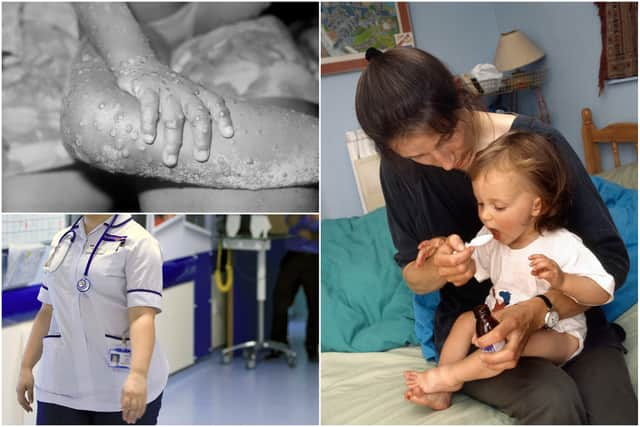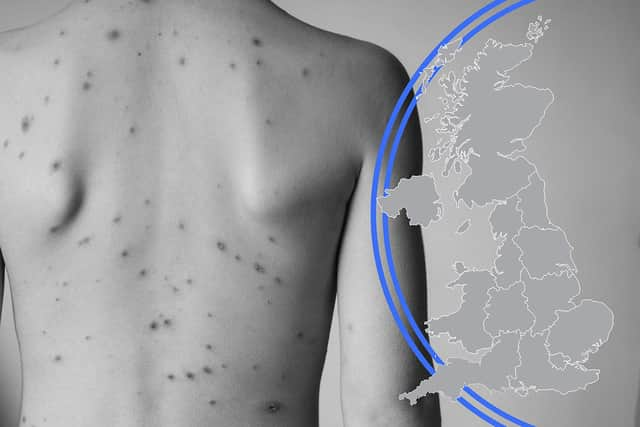How is monkeypox transmitted? How virus infection is spread, and how contagious is it amid UK outbreak
and live on Freeview channel 276
Self-isolation guidance for close contacts of people infected with monkeypox has been issued as the number of UK cases has increased to 470.
The UK Health Security Agency (UKHSA) confirmed on Monday that an additional 104 cases have been identified in England, bringing the total number confirmed in England since 7 May to 452.
Advertisement
Hide AdAdvertisement
Hide AdThere are currently 12 confirmed cases in Scotland, four in Wales and two in Northern Ireland, taking the UK total to 470 as of 12 June.
The first UK case was a person who had recently travelled to Nigeria, which is where they were believed to have contracted the infection, before travelling to the UK.


The UKHSA said the risk to the UK population remains low, but people are asked to be alert to any new rashes or lesions, which would appear like spots, ulcers or blisters, on any part of their body.
This advice applies to everyone, but the majority of the cases identified to date have been among men who are gay, bisexual and men who have sex with men, so these groups in particular are urged to be aware of the symptoms, particularly if they have recently had a new sexual partner.
Advertisement
Hide AdAdvertisement
Hide AdPeople are advised to contact a sexual health clinic immediately if a rash or lesions develop a rash or lesions develop.
Dr Susan Hopkins, Chief Medical Adviser, UKHSA, said: “We are asking people to look out for new spots, ulcers or blisters on any part of their body.
“If anyone suspects they might have these, particularly if they have recently had a new sexual partner, they should limit their contact with others and contact NHS 111 or their local sexual health service as soon as possible, though please phone ahead before attending in person.”
UKHSA health protection teams are contacting people considered to be high-risk contacts of confirmed cases and are advising those who have been risk assessed and remain well to isolate at home for up to 21 days.
Advertisement
Hide AdAdvertisement
Hide AdNew guidance recommends that people who have had “unprotected direct contact or high-risk environmental contact” should isolate for three weeks.
This means that they must not travel or have direct contact with immunosuppressed people, pregnant women and children under 12. They must also provide details for contact tracing and the UKHSA advises that they are offered a smallpox vaccine.


How is monkeypox transmitted?
Monkeypox is a rare infection that is mainly spread by wild animals in parts of west or central Africa, and the risk of catching it in the UK is very low.
The disease, first found in monkeys, is thought to be spread by rodents, such as rats, mice and squirrels, and can be caught if you are bitten by an infected animal, or you touch its blood, body fluids, spots, blisters or scabs.
Advertisement
Hide AdAdvertisement
Hide AdIt may also be possible to catch the disease by eating meat from an infected animal that has not been thoroughly cooked, or by touching other infected products, such as animal skin or fur.
It is very uncommon to get monkeypox from a person who has the infection as it does not easily spread between people, but human-to-human transmission can occur through close physical contact, including sexual intercourse.
The NHS warns that it can be spread through:
- touching clothing, bedding or towels used by someone with the monkeypox rash
- touching monkeypox skin blisters or scabs
- the coughs or sneezes of a person with the monkeypox rash
Dr Hopkins, chief medical adviser for UKHSA, said that monkeypox is spreading through community transmission and warned that doctors are seeing community transmission, with cases predominantly being identified in individuals who self-identify as gay or bisexual or men who have sex with other men.
The health body is asking these groups “to be alert” to possible symptoms, which include rashes or lesions on any part of their body, especially their genitalia, and to contact a sexual health service if they have concerns.
How contagious is it?
Advertisement
Hide AdAdvertisement
Hide AdHuman-to-human transmission of monkeypox is relatively limited, according to the World Health Organisation (WHO).
However, it is possible for it to spread from close contact with respiratory secretions, skin lesions of an infected person, or recently contaminated objects, but transmission via droplet respiratory particles usually requires prolonged face-to-face contact.
Infection with monkeypox virus begins with an incubation period, which averages between seven and 14 days, but can range from five to 21 days. A person is not contagious during this period and will usually not have symptoms.
Those infected with monkeypox will develop an early set of symptoms, including fever, headache and weakness, and may sometimes be contagious during this period.
Advertisement
Hide AdAdvertisement
Hide AdFollowing this, lesions will develop in the mouth and on the body and will progress through several stages before falling off. A person is contagious from the onset of lesions through to the scab stage.
What are the symptoms of monkeypox?
If you are infected with monkeypox, it can take between five and 21 days for the first symptoms to appear. The first symptoms include:
- a high temperature
- a headache
- muscle aches
- backache
- swollen glands
- shivering (chills)
- exhaustion
A rash usually appears between one and five days after the first symptoms, and will typically begin on the face before spreading to other parts of the body.
The rash is sometimes confused with chickenpox as it starts as raised spots, which turn into small blisters filled with fluid.
These blisters eventually form scabs which later drop off and symptoms should clear up within two to four weeks.
Comment Guidelines
National World encourages reader discussion on our stories. User feedback, insights and back-and-forth exchanges add a rich layer of context to reporting. Please review our Community Guidelines before commenting.
